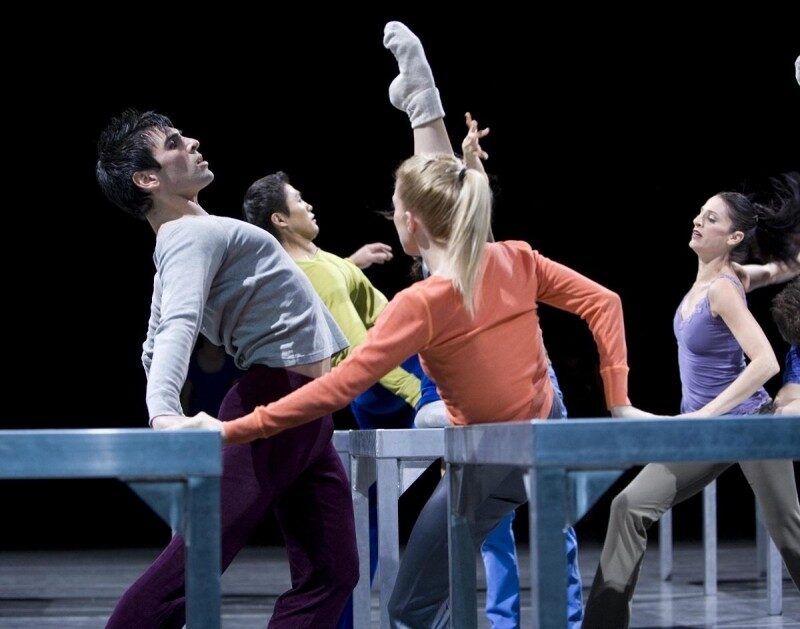THROWBACK: Three Teen Takes on PNB’s One Flat Thing

When Pacific Northwest Ballet premiered William Forsythe's One Flat Thing Reproduced in 2008 it caused quite a stir, polarizing audiences and prompting questions about what defines "ballet." In early versions of the Press Corps, teen reviewers tackled the debut of One Flat Thing. Read these impressions from 10 years ago, then go see it for yourself! The piece has been remounted this weekend in PNB's Director's Choice program!
"Calculated Chaos" By Greta R.
A dancer's leg kicks upward at the exact moment that an adjacent dancer's arm shoots outward and hand clenches; the two are divinely connected for this second, before their bodies twist in different directions. Every limb of every dancer is on a pivot, malleable and boneless as the dancers navigate a grid of 20 metal tables that they themselves pushed onto the stage in a charging herd. A pelvis juts and a skin turns itself inside out as numerous bodies malfunction like broken toys rewired with a mistaken circuit. This calculated chaos is contained in the sounds of a long-forgotten arcade game, one that hums and whirs and occasionally remembers how to simulate a booming crash.
In One Flat Thing Reproduced choreographer William Forsythe gives each dancer a unique mechanical manual while still orchestrating unity through parallels in movements and sound, all propelling the eeriness and worsening the itch that can't be reached. Synchronization is sparse and abstract, but powerful: motion ceases in all but one dancer, as she traverses despite her contortions, dragging her palm across the table surface, contracting and retracting desperately. This is not traditional ballet; the dancers do not go on pointe but instead the balls of their feet can be heard lifting from the ground and onto the tables. Their faces are not bright but harrowed. They wear loose and nondescript "uncostumed" clothing, the comfort in dress heightening the discomfort of the performance, making misplaced elbows and the soft crackling of dynamite too natural.
The production is 25 minutes of constant movement and unease. Bodies move fluidly and efficiently, not like cogs in a machine but each an individual engineer of madness.

"Impossible Lengths" By Yasmeen B.
The movements of the seemingly spineless dancers in William Forsythe's One Flat Thing, Reproduced emulate one of the most iconic scenes in all of cinema: Linda Blair's stomach-churning, 180-degree head turn in The Exorcist. This piece, set to an eerie soundtrack that would be right at home in the 1973 horror classic, features fourteen dancers twisting their bodies in the most impossible shapes. The possessed contortionists twist and turn their limbs and joints in impossible directions and angles. The dancers are not completely boneless, however. In the midst of all this fluid motion, they strike angular poses and bend their arms and legs in a way that resembles spider legs, which only add to the creepiness of the piece.
The set, which seems to be some sort of industrial warehouse, has the dancers weave in and out of and slide across twenty tables-the only visible objects-arranged in rigid lines that are juxtaposed against the flowing motions of the dancers but complement their angular motions as well. Many of the movements in this piece also have an athletic feel. The dancers stretch their bodies to impossible lengths and use the tables similar to how gymnasts use parallel bars, lifting their bodies off the ground and swinging on them. This athleticism is reflected in the costumes, which seem very much like basic workout wear: sweatpants, plain tops, muscle tanks.
Forsythe builds tension in One Flat Thing, Reproduced as the dancers make quick and rapid movements and then slow down considerably for a second, then pick up their original pace again. This pattern is repeated throughout the piece and creates an unsettling mood. The viewer is on edge, never fully certain of what will happen next. The difficulty of pinpointing exactly what kind of dance this is-ballet? modern? contemporary? -only adds to the ominous atmosphere.

"Strange Beauty" By Leah D.
As the production begins, two dancers crawl under tables, their shoulders angular and movements eerie, faces flitting in and out of the shadows. The dancers look bored and confused--their movements are random, unpredictable and oddly sinister. This intro sets the mood for William Forsythe's disturbing modern dance piece, One Flat Thing, Reproduced.
The dancers move around 20 tables like contortionists, their motions seemingly controlled by an evil spirit. Their arms spasmodically twitch like insects. They dance like broken puppets, making shapes with their bodies that seem to defy human anatomy. Sometimes they intermittently freeze for several seconds or even a minute. They heave, yank, strike, or kick each other in private moments of connection, creating a great sense of intrigue.
The music is composed of haunting sounds and static, mixed with the acoustic noises of the dancer as they intentionally smack the tables. The music is a lot of clicking and buzzing with shrill overtones, much like the soundtrack to an episode of The X Files. It fits perfectly with the dance, and seems to direct the motions of the dancers. They are not dancing to it, they are dancing with it. The music is very successfully used to set an unsettling tone of agitation.
There is an overall feeling of chaos and a loss of control or order. No longer is dance structured and controlled, but in this number, it is primitive and wild looking. No pointe shoes or white tutus here. William Forsythe is setting the standard of a new kind modern dance. And while it is not ballet, his unorthodox choreography has a value and strange beauty that keeps your eyes glued to the production.
______________________________
Want to learn more about the TeenTix Press Corps? It's back and better than ever! This page has the most up-to-date info about one of our most beloved programs.



